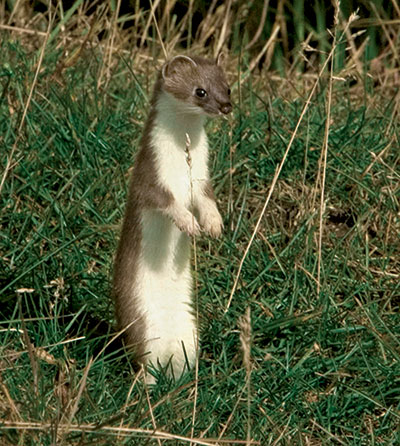 Photo courtesy of USFWS/Steve Hillebrand. Indiana has two native species of weasels, the long-tailed weasel (Neogale frenata) and the least weasel (Mustela nivalis). Long-tailed weasels are the widest-ranging weasel in the country—they are found in almost every state in the continental United States. The long-tailed weasel is also the largest of the three weasel species found in the U.S. though it is only a little larger than its northern cousin the short-tailed weasel (Mustela erminea). The least weasel is the smallest carnivore in the world, weighing, on average, about the same as a golf ball.
Photo courtesy of USFWS/Steve Hillebrand. Indiana has two native species of weasels, the long-tailed weasel (Neogale frenata) and the least weasel (Mustela nivalis). Long-tailed weasels are the widest-ranging weasel in the country—they are found in almost every state in the continental United States. The long-tailed weasel is also the largest of the three weasel species found in the U.S. though it is only a little larger than its northern cousin the short-tailed weasel (Mustela erminea). The least weasel is the smallest carnivore in the world, weighing, on average, about the same as a golf ball.
Similar Species
General Characteristics
- Long-tailed weasels have long bodies with short legs and are brown above with yellow or white underparts.
- Long-tailed weasel tails are more than 4 inches long and have a black tip.
- Least weasels also have short legs and are mostly brown with white underparts. They are usually less than 8 inches long, including the tail.
- Least weasels have a short tail with no black tip.
- Both weasels may turn white in winter; however, most in Indiana do not because the snow conditions are not sufficient for them to gain an advantage by turning white.
Distribution and Abundance
Weasels are not well studied in Indiana, and there is limited information available about either species. Long-tailed weasels seem to be statewide, but records of them are sporadic. Least weasels also have sporadic records available. They may be statewide, but more records are available from the north and east portions of Indiana.
Reproduction
Long-tailed weasels have delayed implantation, so they mate in summer and give birth to an average of four to eight young approximately 280 days later in the next spring. Young stay with the mother until mid-summer and are about full size within two to three months. Males do not help raise young. Least weasels do not have delayed implantation and generally mate between April and July and give birth to an average of six young approximately 36 days later. Young disperse to live on their own after three months. Least weasel males do not help raise young.
Food Habits
Both species of weasel are primarily carnivores. The primary food for both weasels are:
- Mice
- Voles
- Other small mammals
Both weasels will also eat:
- Squirrels
- Rabbits
- Birds
- Eggs
- Frogs
- Insects and invertebrates
Viewing Tips
Weasels are small, fast, and tough to see. They like thick cover for places to hide and must be active day and night to find enough food for their fast metabolisms. Brush piles, wood piles, culverts, and brushy areas can all be places to spot a weasel, but they’ll be hard to see, even if they are there. Places like Kingsbury Fish & Wildlife Area, which may have brushy areas among networks of ditches can have good spots to sit quietly and hope for a sighting of a weasel.
Management and Control
Long-tailed weasels may be legally trapped during the regulated season. Landowners, or a person with written permission from a landowner, may take long-tailed weasels year-round on private property without a permit from the DNR. A landowner does not need a permit to take long-tailed weasels on the landowner’s property, but a hunting or trapping license is required to take long-tailed weasels on land other than your own.
Least weasels are a species of special concern in Indiana. Because their small size and secretive nature make them hard to research effectively, not much is known about them. Least weasels can be captured or killed year-round without a permit or hunting or trapping license from the DNR, and there are no limits to the number that can be taken.
To get help with a nuisance weasel, contact a licensed wildlife control operator.
